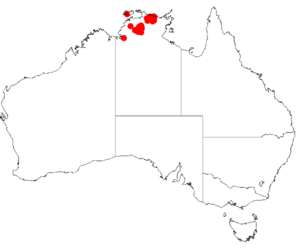Acacia cataractae facts for kids
Quick facts for kids Acacia cataractae |
|
|---|---|
| Scientific classification | |
| Genus: |
Acacia
|
| Species: |
cataractae
|
 |
|
| Occurrence data from AVH | |
Acacia cataractae is a type of shrub. It belongs to the large Acacia plant family. This plant is found only in northern Australia. It was officially named by scientists Mary Tindale and Phillip Gerhard Kodela.
What it Looks Like
This shrub usually grows up to 2 meters (about 6.5 feet) tall. It has brown bark that looks like fibers. Its branches are smooth and have small, wavy ridges.
Leaves and Flowers
Like many Acacia plants, Acacia cataractae does not have true leaves. Instead, it has special flattened stems called phyllodes. These phyllodes are evergreen, meaning they stay green all year. They are flat and can be straight or slightly curved.
The phyllodes are smooth and feel a bit like leather. They are about 4 to 10.5 centimeters (1.6 to 4.1 inches) long. They are also about 6 to 23 millimeters (0.2 to 0.9 inches) wide. Each phyllode has three clear lines, or veins, running along it.
This plant blooms between December and July. During this time, it produces beautiful golden flowers. The flowers grow in cylinder shapes, like small spikes. These flower spikes are found alone or in groups of two or three. They grow where the leaf meets the stem. The spikes are about 1 to 5 centimeters (0.4 to 2 inches) long. They have bright to golden yellow flowers.
Seed Pods and Seeds
After the flowers bloom, woody, brown seed pods form. These pods are narrow and get thinner towards their base. They can be straight or slightly curved. The pods are about 2.6 to 5 centimeters (1 to 2 inches) long.
Inside the pods, the seeds are arranged at an angle. The seeds are shiny and brown. They are about 2.7 to 5.3 millimeters (0.1 to 0.2 inches) long. Each seed has a special cone-shaped part called an aril.
Where it Lives
Acacia cataractae is found only in the northern parts of the Northern Territory in Australia. This means it is endemic to that area. You can find it on Bathurst Island. It also grows from around Maningrida in the north. Its range extends south to Umbrawarra Gorge, near Pine Creek.
This plant often grows near streams. It likes areas with sandstone plateaus and gorges. It can also be found on coastal flats. In these places, it typically grows in sandy soils.

